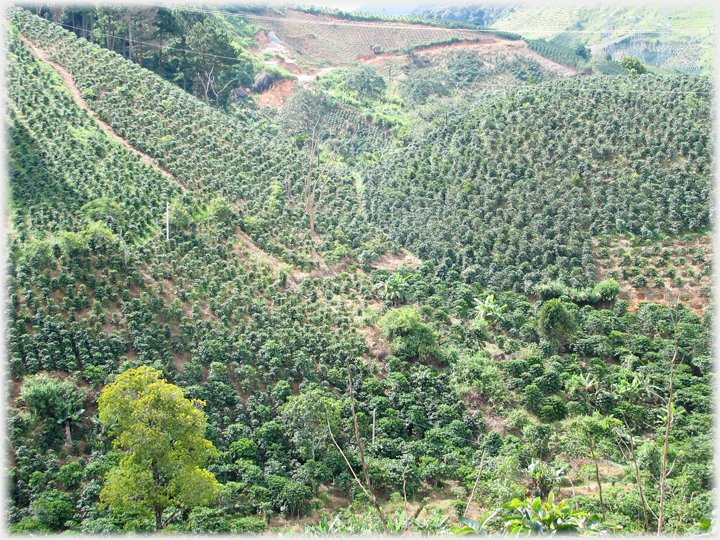

Economic Migrants
This huge redistribution [of the population in China] was partly due to absolute growth in other provinces, but was also fuelled by westward migration ... A central official ... was struck by the number of “out-of-province, out-of-prefecture, out-of-subprefecture, and out-of-county people” ...almost all of them economic migrants
Timothy Brook (2010)

Human voluntary migration is mostly economic. Brook is describing such ‘redistributions’ in China’s Minh dynasty, these had been assisted by government inducement, as were the ones, centuries later, in Vietnam, and which the hillsides in the photograph illustrate. Here was virgin jungle as recently as the middle of last century when Georges Condominas wrote about the area as
undisturbed
 Condominas’ descriptions chime well with the writings of Wendell Berry.
forest. However, after the American War, Vietnam needed to exploit all economic possibilities. Mass movements ensued, which saw the jungles
cleared
Condominas’ descriptions chime well with the writings of Wendell Berry.
forest. However, after the American War, Vietnam needed to exploit all economic possibilities. Mass movements ensued, which saw the jungles
cleared
 Some believe that any such large changes we inflict on our environment is damaging..
and coffee planted, leading to Vietnam now being the world’s second biggest coffee exporter. Jumping again, this time across the world: numbers of people from southern England, spotting cheap housing in Scotland (arising due to government policies) have bought property here and moved north - often without viewing. Such migrants, commonly and unselfconsciously, maintain attitudes from their
origins
Some believe that any such large changes we inflict on our environment is damaging..
and coffee planted, leading to Vietnam now being the world’s second biggest coffee exporter. Jumping again, this time across the world: numbers of people from southern England, spotting cheap housing in Scotland (arising due to government policies) have bought property here and moved north - often without viewing. Such migrants, commonly and unselfconsciously, maintain attitudes from their
origins
 What happens to our roots when we migrate?
and are impervious to local norms, while vociferously voicing dislike of economic migrants who fail to integrate fully in the south of Britain. Economic migration seems
universal,
What happens to our roots when we migrate?
and are impervious to local norms, while vociferously voicing dislike of economic migrants who fail to integrate fully in the south of Britain. Economic migration seems
universal,
 To another social process that leads to problems if pursued en masse.
and universally challenging in its manifestations.
To another social process that leads to problems if pursued en masse.
and universally challenging in its manifestations.
This quote is from page 47 of Brook’s book The Troubled Empire, published by Harvard University Press. He is quoting from the Huguang Gazateer of 1522. Huguang roughly corresponds to modern Hubei and Hunan Provinces. Georges Condominas’ book, We Have Eaten the Forest, describing life in that area of Vietnam, was published in France in 1957 and translated by Adrienne Foulke and published in English in 1977 by Allen Lane.
This photograph of coffee plantations was taken near Phi Di Ya in the north-western corner of Lâm Đồng Province in southern Vietnam.
Above, hovering on blue introduces a link: click to go, move away to stay.

Saturday 8th November 2025
 ...guide to this site
...guide to this site